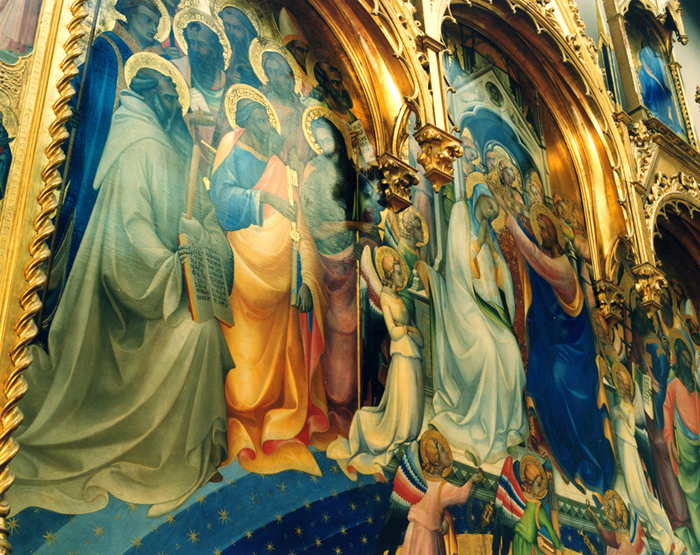
Impossible Gaze #13
Origin: Room 5-6 – International Gothic
Detail: Lorenzo Monaco , Coronation of the Virgin, 1414
Galleria degli Uffizi
Impossible Gaze brings the viewer face-to-face with the past. The artworks and their adornment are pre-mechanized, unique, and handcrafted, all of which contribute to the aura and authenticity that has been so debated by authors from Walter Benjamin to contemporary theorists like Susan Stewart and Celeste Olaquaiga. Though Benjamin is in favor of the disintegration of aura associated with original artworks, he commented that “even the most perfect reproduction of a work of art is lacking in one element: its presence in time and space, its unique existence at the place where it happens to be.” 1 Here Benjamin confims the significance of the contextualizing space. Museums like Palazzo Pitti, impregnated with history, intensify the viewer's experience of art and foster the sense of authenticity. Even though the works may not have been originally intended for Pitti, nor are the interiors completely original, a “unique existence” remains. The relationship between the artwork and its physical location is a palpable, “authenticating” and “auratic” context , one that Impossible Gaze attempts to evoke. These images constitute another uncanny act of doubling, where the strangeness of making a photographic reproduction - which by its very nature according to Benjamin, strips away the notion of aura - also somehow represents it.
The color of pigment and fabric, the textures of lustrous gilding and threadbare seams, the inevitable wear, and obvious repairs weave an intricate pattern of individuals, culture, craftsmanship, and history. The evidence of those who have cared for the art through the centuries is seen in every hand-carved acanthus leaf, stitch of brocade, fabric-covered wall, and extravagant frame. And in each painting, its warped panels, over-painting, pentimenti, sgraffito, brushstrokes, gilding, surface texture, and restorations immortalise the architects of these interiors. The chipped furniture with upholstery is worn and cracked, and the stains and frayed edges signal that time has helped author their appearance. Inscribed with the weight of the past, these decorative surfaces speak implicitly of the humanity that created it.
1. Benjamin, 220.